By Jeff Moorman, photos by Jeff Moorman
Next Clinic:
Thursday (December 4) is our next clinic meeting. Mike Bjork will present a PowerPoint on the Washington and Idaho Railway (WIR), from the perspective of both a former employee and a consulting engineer providing design and construction services. This railroad is a contemporary shortline and you can probably guess in which two states it operates.
Prior Clinic:
Our clinician last time was our own Dennis T who showed us how to use a smart phone as a wireless DDC throttle. But, it is not as simple as just whipping out your phone and taking over control of someone’s locomotive.
First you need some trains to run and a place to run them. Dennis provided this by setting up a little 6½’ by 2½’ T-TRAK oval in N scale.
Second you need the layout to be operated by DCC. Dennis uses a Digitrax system, but others would work provided they can be interfaced to a PC running JMRI software. I know this can also be done with NCE systems and there may be others.
That computer interface to your DCC system is the next requirement. This is not the simple interface needed to program decoders, but rather a connection to the Digitrax LocalNet. Dennis used the Digitrax PR3 USB interface which also has a LocalNet connection.
Fourth that interface needs to be connected to a PC running JMRI software. Next that computer needs to be connected to a Wi-Fi network as does your smartphone.
And, finally, your smartphone needs to be running a JMRI compatible throttle app. Dennis used the WiThrottle Lite app. This is the free version of WiThrottle, and it runs on iPhones and iPods. There is a similar app called Engine Driver for Android devices.
Note that the wireless capability for this set-up utilizes a Wi-Fi network, not the phone’s Bluetooth or cell connection.
WiThrottle Lite has the basic controls, but you’ll need its commercial version for complex consisting. In some respects for new operators sliding your finger on the screen to change the throttle settings is more intuitive than a thumbwheel or speed buttons found on many DCC throttles.
Let’s face it – buying a smartphone in order to have a wireless throttle might be an expensive proposition. But if you already have the phone, and may only occasionally need a wireless throttle or throttles (like when the gang comes over for a little switching every other month) this may be just the ticket. Plus, there are ‘cool factor’ points to be won by pulling out your phone and running a train.
So, let’s review. In order to control a model railroad locomotive from your smartphone you need:
- A smartphone with a JMRI-compatible throttle app
- A wireless computer network, which supports a connection to both your smartphone and your computer
- JMRI software running on the computer
- An interface between the computer and your DCC system
- A DCC system connected to a model RR layout
- A DCC-equipped locomotive on the layout
It sounds complex, but you probably already have most of the components. It is mostly just a matter of hooking them all together.
Several attendees had previously downloaded a throttle app (or did so during the clinic) and all were all able to run locos via the infrastructure Dennis had set up.
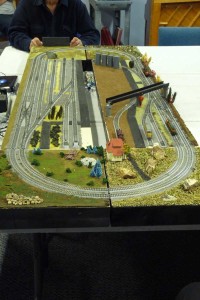
T-TRAK Layout 1 of 2
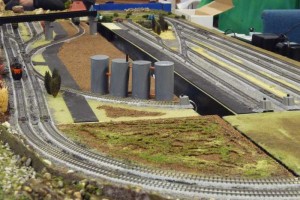
T-TRAK Layout 2 of 2
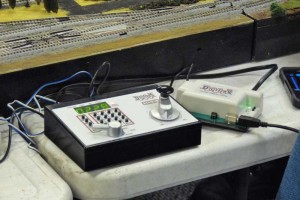
DCC Control Unit and PC Interface
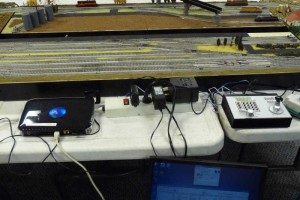
More of the PC to DCC set up
Show and tell started with a follow-on discussion about DCC in general and then about T-TRAK modules. Plus, Chris F had some more of his ongoing HO passenger car project to show us.
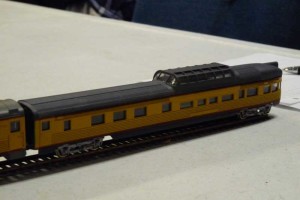
Chris’ Passenger Cars 2 of 2

Chris’ Passenger Cars 1 of 2
Directions: We meet at the Ronald United Methodist Church, 17839 Aurora Avenue North, Shoreline, WA. That is on the west side of Aurora (State Route 99) between 175th and 185th Streets and more specifically, between the Cadillac dealer on the south and Deseret Industries to the north. Going southbound on Aurora, make a right-hand turn into the church driveway immediately after passing the Deseret location. The parking lot is at the rear of the church. For regular meetings go up the steps to the main entrance. We meet in the Fireside Room which is immediately to the left inside the door.
Meetings are the first Thursday of each month, usually September – June. However in June we often do something different, so there may be no “regular” meeting. Doors open at 7:00 PM and the program starts at 7:30.
Remember the next regular evening meeting is December 4. Hope to see you there or at least sometime on down the line.

No Comments Yet